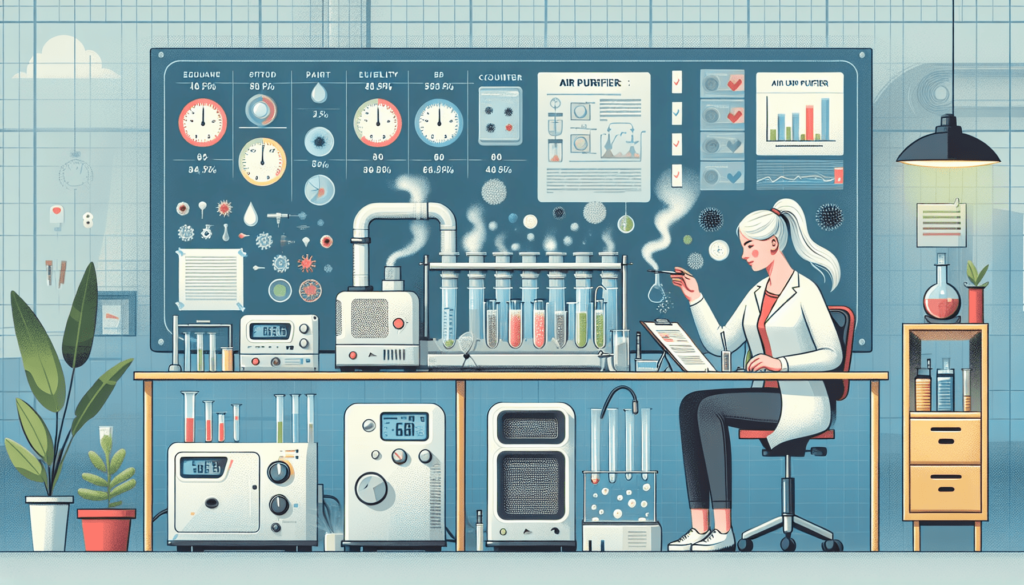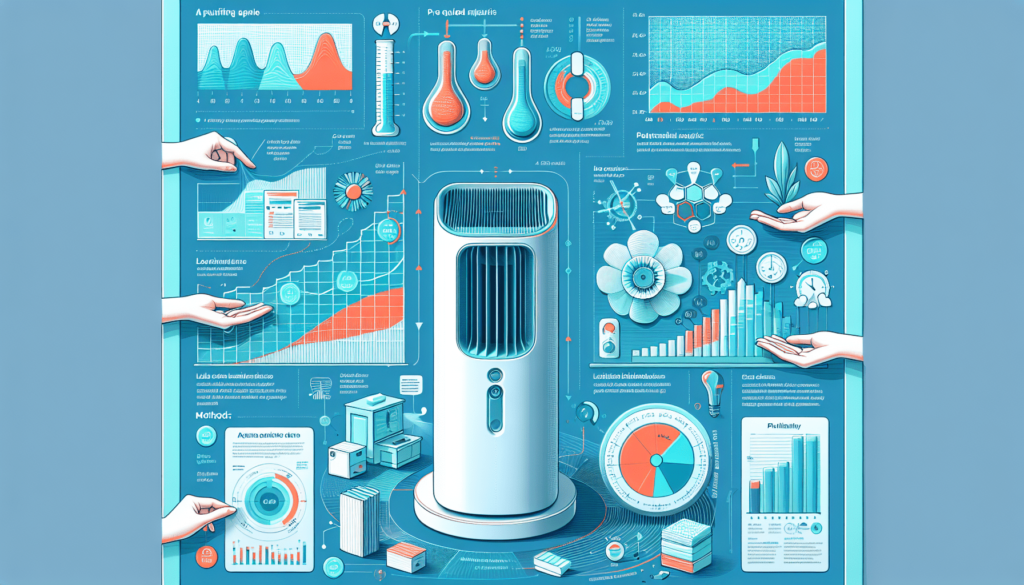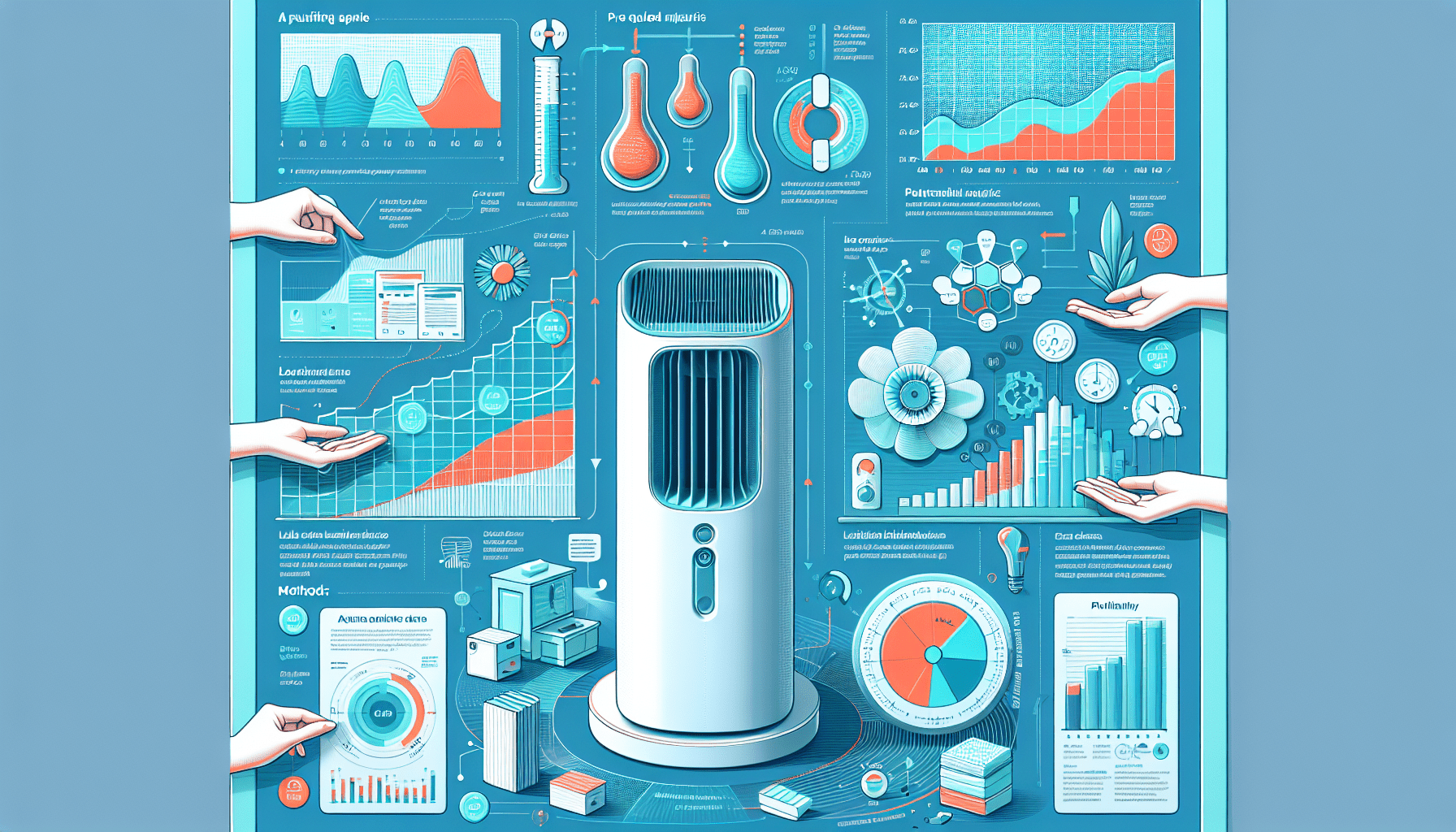You’ve invested in an air purifier to ensure that the air in your home remains clean and fresh, but how can you be certain that it’s actually doing its job? In this article, we will explore several simple yet effective methods that will help you determine if your air purifier is indeed working efficiently. By following these tips, you can have peace of mind knowing that the air you and your family breathe is free from contaminants and allergens.

Checking Air Quality
Using a Particle Counter
One of the most effective ways to check the air quality in your home is by using a particle counter. This handy device measures the number and size of particles in the air, giving you a clear indication of the air quality. Simply turn on your air purifier and place the particle counter near it. Let it run for a few minutes and then check the readings. A lower number of particles indicates cleaner air, proving that your air purifier is doing its job.
Observing Dust and Allergy Symptoms
Another telltale sign that your air purifier is working is a decrease in dust and allergy symptoms. If you notice a significant reduction in dust settling on surfaces and less frequent sneezing, coughing, or itching, then it’s a good indication that your air purifier is effectively filtering out dust particles and allergens. Keep in mind that it may take some time for noticeable improvements, especially if the air quality was heavily polluted before using the purifier.
Noticing Odor Reduction
Air purifiers not only filter out particles, but they also help eliminate odors in the air. If your air purifier is working correctly, you should notice a decrease in unpleasant smells in your home. Whether it’s pet odors, cooking smells, or musty odors, a good air purifier will help neutralize them, leaving your home smelling fresh and clean. Remember that not all air purifiers are designed to eliminate specific smells, so choose one that suits your specific needs if odors are a major concern.
Monitoring Air Purifier Performance
Checking Filter Indicators
Most modern air purifiers come equipped with filter indicators, which are helpful tools to monitor the performance of your purifier. These indicators generally use color-coded lights or digital displays to notify you when it’s time to replace the filters. By regularly checking these indicators, you can ensure that your air purifier continues to work effectively and efficiently. Replace the filters as recommended by the manufacturer to maintain optimal air quality.
Inspecting Dust Build-Up
Over time, dust particles may accumulate on the surface of your air purifier, indicating that it is capturing airborne particles effectively. Monitoring the amount of dust build-up on the exterior or inside panels of the purifier can provide an indication of its performance. Take note of the frequency and amount of dust you need to clean off, as an increase in dust accumulation may suggest a reduction in the purifier’s efficiency. Regularly wipe down the exterior of your air purifier to keep it performing optimally.
Measuring Airflow
Another way to monitor your air purifier’s performance is by measuring the airflow it produces. Place your hand a few inches away from the purifier’s air vent or grille and feel for a steady stream of air. A lack of airflow may indicate a clogged filter or a malfunction in the purifier’s fan. Additionally, if the airflow feels weaker than before, it might be a sign that the filters need to be replaced. Monitoring the airflow can help you identify any potential issues with your air purifier early on.
Testing Air Purifier Effectiveness
Using Smoke Test
To determine the effectiveness of your air purifier in removing small particles from the air, you can conduct a smoke test. Light a match or a candle, blow it out, and then hold it near your air purifier. Observe how quickly the purifier is able to clear the smoke. A high-performing air purifier should swiftly capture and remove the smoke particles from the surrounding air. If the smoke dissipates slowly, it may indicate that your air purifier is not as effective in filtering out fine particles.
Conducting Mold Spore Test
Mold spores are a common allergen and may be present in the air, even if they are not visible to the naked eye. To test your air purifier’s effectiveness in capturing mold spores, you can purchase a mold spore test kit. These kits typically consist of a petri dish with a growth medium and a lid. Place the open petri dish near your air purifier and let it sit for a designated period. Then, seal the dish and follow the kit’s instructions to allow any mold spores to grow. Compare the results with a control dish placed in another area of the room to assess your air purifier’s mold-capturing abilities.
Performing Pet Dander Test
If you have pets at home, monitoring the effectiveness of your air purifier in capturing pet dander is essential. Pet dander, which consists of tiny particles of skin and fur, can trigger allergies in some individuals. To conduct a pet dander test, use a black cloth or piece of tape and run it over surfaces where your pets frequent, such as furniture or bedding. Take note of the amount of pet dander present. Then, turn on your air purifier and let it run for a few hours. Repeat the test in the same areas and compare the results. A reduction in pet dander indicates that your air purifier is effectively capturing and filtering out these allergenic particles.
Considering Room Size and Purifier Capacity
Determining Appropriate Purifier Size
When choosing an air purifier, it’s crucial to consider the size of the room where you intend to use it. Different air purifiers are designed for different room sizes. To determine the appropriate purifier size, measure the square footage of the room. Most manufacturers provide a recommended room size for each model, indicating the maximum square footage the purifier can effectively clean. Choose a purifier that matches or exceeds the size of the room to ensure optimal air purification and circulation.
Calculating Air Changes per Hour (ACH)
Apart from room size, you should also consider the air changes per hour (ACH) that an air purifier offers. ACH refers to the number of times an air purifier can filter and clean the entire volume of air in a room within an hour. Higher ACH rates provide more frequent air purification, making them suitable for individuals with allergies or respiratory conditions. To calculate ACH, divide the purifier’s recommended room size by the volume of air it can filter per hour. Aim for at least four to six air changes per hour for optimal purification.

Analyzing Energy Consumption
Reviewing Energy Usage Data
Before purchasing an air purifier, it’s helpful to review the energy usage data provided by the manufacturer. This information allows you to understand the power consumption of the purifier and estimate its impact on your energy bill. Look for the purifier’s wattage rating, which indicates the amount of power it uses. Additionally, consider any energy-saving features, such as programmable timers or low-power modes, which can help reduce energy consumption.
Comparing Energy Efficiency Ratings
In addition to reviewing energy usage data, comparing energy efficiency ratings can further guide your decision-making process. Energy Star labels are a reliable source of information when considering energy-efficient appliances, including air purifiers. These labels indicate that a product has met or exceeded strict energy efficiency standards set by the Environmental Protection Agency (EPA). Look for the Energy Star label and compare the energy efficiency ratings of different air purifiers to choose one that minimizes energy consumption while maintaining effective air purification.
Considering Noise Level
Evaluating Manufacturer’s Noise Level Information
Noise level is an important factor to consider when selecting an air purifier, especially if you plan to use it in a bedroom or workspace. Before purchasing, evaluate the manufacturer’s noise level information provided in the product specifications. Look for decibel (dB) ratings, which indicate the sound intensity produced by the air purifier. Lower dB ratings indicate quieter operation. Keep in mind that some air purifiers have different speed settings, and noise levels may vary between settings. Consider whether a quieter operation is important to you and select a model accordingly.
Reading Consumer Reviews
In addition to the manufacturer’s information, reading consumer reviews can provide valuable insights into the real-world noise levels of air purifiers. Look for reviews that specifically discuss noise and gather opinions from different sources. You can also consider noise-reducing features, such as sleep modes or quiet operation settings, which can help minimize noise levels and ensure a peaceful environment while the air purifier is in use.
Reviewing Air Purifier Lifespan
Checking Manufacturer’s Recommendations
Different air purifiers have varying lifespans, and it’s essential to check the manufacturer’s recommendations on how long the purifier can operate effectively. Some manufacturers provide guidelines for the average lifespan of the unit, including the expected longevity of various components. Following these recommendations can help ensure that your air purifier continues to provide clean air without any significant decline in performance. Regularly assess the age of your air purifier and consider replacing it when it reaches the end of its recommended lifespan.
Inspecting Filter Lifespan
Filters play a crucial role in air purification, but they require regular maintenance and replacement. Check the manufacturer’s recommendations regarding filter lifespan, as this can vary depending on the specific air purifier model and usage. Some filters may need replacement every three to six months, while others may last up to a year or longer. Generally, air purifiers with longer-lasting filters may be more cost-effective in the long run, as you won’t need to replace them as frequently. Regularly inspect and replace filters as directed to maintain optimal air purification and prolong the lifespan of your air purifier.
Comparing Air Quality Before and After
Using Air Quality Sensors
Air quality sensors are devices that measure the levels of pollutants, particles, and other contaminants in the air. They can be used as an effective tool to assess air quality before and after using an air purifier. Prior to using the purifier, place the air quality sensor in the room and record the readings. After using the purifier for a considerable period, take another set of readings to compare the air quality improvements. This method provides objective data to determine the effectiveness of the air purifier in improving the overall air quality in your home.
Analyzing Data from a Monitoring Device
Another way to compare air quality before and after using an air purifier is by using a monitoring device. These devices continuously measure and record various air quality parameters, such as particulate matter levels, humidity, and temperature. By reviewing the data collected before and after using the air purifier, you can assess any improvements in air quality. Monitoring devices provide detailed insights over an extended period, allowing you to make informed decisions about the effectiveness of your air purifier and potentially make adjustments to optimize air purification.
Consulting Professionals
Seeking Expert Advice
If you are unsure about the performance or effectiveness of your air purifier, seeking expert advice can be beneficial. Indoor air quality professionals can assess the specific needs of your home and provide personalized recommendations. They can evaluate your air purifier’s performance, suggest improvements if necessary, and guide you through additional steps you can take to enhance air quality. Expert advice ensures that you have a comprehensive understanding of your air purification system and how to maintain optimal air quality in your living space.
Hiring Indoor Air Quality Specialists
In some cases, particularly if you have persistent air quality issues or specific concerns, you may consider hiring indoor air quality specialists. These professionals have in-depth knowledge and expertise in assessing and improving indoor air quality. They can conduct comprehensive air quality tests, identify potential sources of pollutants, and recommend specific air purifiers tailored to your needs. Hiring indoor air quality specialists can give you peace of mind, knowing that you are taking the necessary steps to ensure the health and well-being of yourself and your family.
Routine Maintenance and Cleaning
Following Manufacturer’s Cleaning Instructions
To keep your air purifier functioning optimally, it’s important to follow the manufacturer’s cleaning instructions. These instructions typically provide guidance on cleaning the exterior surfaces, fan blades, and vents of the purifier. Regular cleaning helps prevent dust build-up, maintains proper airflow, and ensures that the purifier continues to effectively capture and filter out airborne particles. Make it a habit to clean your air purifier according to the manufacturer’s recommendations to prolong its lifespan and maintain superior air quality.
Regularly Replacing Filters
Replacing filters on a regular basis is essential for the long-term performance and effectiveness of your air purifier. Follow the manufacturer’s guidelines regarding filter replacement intervals, as exceeding these recommendations may lead to decreased filtration efficiency. Set reminders or create a schedule to ensure timely filter replacements. Keep spare filters on hand so that you can easily swap them out when needed. Regular filter replacement guarantees that your air purifier consistently provides clean and fresh air, promoting a healthier living environment.
In conclusion, checking the air quality, monitoring the performance, testing effectiveness, considering room size and purifier capacity, analyzing energy consumption, evaluating noise level, reviewing lifespan, comparing air quality before and after, consulting professionals, and practicing routine maintenance and cleaning are all crucial steps to ensure that your air purifier is working effectively. By following these guidelines and regularly assessing your air purifier’s performance, you can breathe easy knowing that your home is filled with clean and fresh air, promoting a healthier living environment for you and your loved ones.

